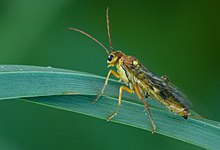
Back زنبوريات نباتية Arabic زنبوريات نباتيه ARZ Пільшчыкі сапраўдныя BE Tentredínids Catalan Tenthredinidae CEB Pilatkovití Czech Echte Blattwespen German Tenthredinidae Spanish Lehevaablased ET زنبورهای برگخوار FA
| Tenthredinidae | |
|---|---|

| |
| Female Tenthredopsis sordida | |
| Scientific classification | |
| Domain: | Eukaryota |
| Kingdom: | Animalia |
| Phylum: | Arthropoda |
| Class: | Insecta |
| Order: | Hymenoptera |
| Suborder: | Symphyta |
| Superfamily: | Tenthredinoidea |
| Family: | Tenthredinidae Latreille, 1802[1] |
| Type genus | |
| Tenthredo | |
| Subfamilies | |
|
Allantinae | |

Tenthredinidae is the largest family of sawflies, with well over 7,500 species worldwide,[2] divided into 430 genera. Larvae are herbivores and typically feed on the foliage of trees and shrubs, with occasional exceptions that are leaf miners, stem borers, or gall makers. The larvae of externally feeding species resemble small caterpillars. As with all hymenopterans, common sawflies undergo complete metamorphosis.
The family has no easily seen diagnostic features, though the combination of five to nine antennal flagellomeres plus a clear separation of the first abdominal tergum from the metapleuron can reliably separate them. These sawflies are often black or brown, and 3 to 20 mm long. Like other sawflies, they lack the slender "wasp-waist", or petiole, between the thorax and abdomen, characteristic of many hymenopterans. The mesosoma and the metasoma are instead broadly joined. The Tenthredinidae are also often somewhat dorsoventrally flattened, which will distinguish them at least from the slender cephids (which, together with the common sawflies, comprise many of the Nearctic species of Symphyta).
Females use their saw-like ovipositors to cut slits through barks of twigs, into which translucent eggs are wedged, which damages the trees. They are common in meadows, and in forest glades near rapid streams. Adults eat little, while larvae feed on foliage of streamside trees and shrubs, especially willow.
A number of species and genera have been described from the fossil record such as Eriocampa tulameenensis and Pseudosiobla campbelli of British Columbia.[3]
- ^ Liston et al 2014.
- ^ Davis, Robert B; Baldauf, Sandra L; Mayhew, Peter J (2010). "The origins of species richness in the Hymenoptera: insights from a family-level supertree". BMC Evolutionary Biology. 10 (1): 109. Bibcode:2010BMCEE..10..109D. doi:10.1186/1471-2148-10-109. ISSN 1471-2148. PMC 2873417. PMID 20423463.
- ^ Rice, H.M.A. (1968). "Two Tertiary sawflies, (Hymenoptera – Tenthredinidae), from British Columbia". Geological Survey of Canada. 67 (59): 1–21.